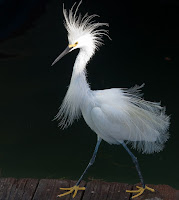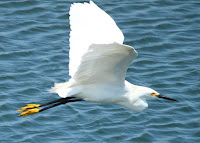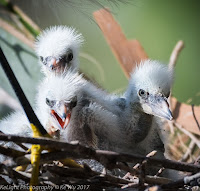SNOWY EGRET
SNOWY EGRET (Egretta thula) – (See images below)
DESCRIPTION: The Snowy Egret is a wading bird that is completely white except for a yellow bare skin patch between the bill base and the eye, which is yellow. Bill and legs are grey with lighter blotches. Feet are yellow. Sexes are similar, juveniles are somewhat duller. Bird length is around 65 cm (25 inches).
VOICE: https://www.xeno-canto.org/species/Egretta-thula
NAME: ‘Snowy’ refers to the bird plumage, NOT its habitat. ‘Egret’ (and Latin genus name ‘Egretta) comes from French ‘aigrette’, referring to this bird’s feathers that were used as ornaments. Latin species name ‘thula’ is Chilean for this species.
HABITAT: Wetlands such as freshwater and saltwater marshes, barrier islands, mangroves, lagoons.
DIET: Fish, insects, amphibians, worms, crustaceans.
NESTING: Nests in colonies in thickly vegetated remote wetland areas. Nest is a platform of sticks in a tree or shrub not far from the ground. Around two to five light blue-greeneggs are laid, incubated by both parents. Chicks fed by both parents.
DISTRIBUTION: Mainly a South American species. Breeds in south-central USA, winters in Mexico and Central America. Year-round resident along the coasts of southeast USA and in Florida, the Caribbean, coasts of Mexico and South America except the Andes and the southern tip. Some individuals will reach Hawaii as vagrants (see note below on bird vagrancy), even Europe.
Distribution Map: https://en.wikipedia.org/wiki/Snowy_egret#/media/File:Egretta_thula_map.svg
ON PEI: Does not breed on Prince Edward Island, sightings occasional in summer.
CONSERVATION: This egret was hunted almost to extinction in the past for its breeding ‘aigrettes’ as ornaments. Population has rebounded since legally protected. Still vulnerable to wetland habitat loss, but not currently listed as a species of concern globally.
Vagrancy: In biology this means an animal going way outside its normal range. For birds, this can happen when there are storms and they get blown off course. On other times, the bird simply wanders in a different direction than usual. Here’s an article about vagrancy in birds.
SIMILAR SPECIES: Little Blue Heron (juvenile), Cattle Egret
REFERENCES: http://fieldguide.mt.gov/speciesDetail.aspx?elcode=ABNGA06030 (Montana Field Guide)
https://en.wikipedia.org/wiki/Snowy_egret
https://www.allaboutbirds.org/guide/Snowy_Egret
https://txtbba.tamu.edu/species-accounts/snowy-egret/ (Texas Breeding Bird Atlas)
https://birdatlas.mb.ca/accounts/speciesaccount.jsp?sp=SNEG&lang=en (Manitoba Breeding Bird Atlas)
https://www.audubon.org/field-guide/bird/snowy-egret
https://identify.whatbird.com/obj/48/_/Snowy_Egret.aspx
https://www.pwrc.usgs.gov/bioeco/snowy.htm
https://birdeden.com/facts-about-snowy-egret
DESCRIPTION: The Snowy Egret is a wading bird that is completely white except for a yellow bare skin patch between the bill base and the eye, which is yellow. Bill and legs are grey with lighter blotches. Feet are yellow. Sexes are similar, juveniles are somewhat duller. Bird length is around 65 cm (25 inches).
VOICE: https://www.xeno-canto.org/species/Egretta-thula
NAME: ‘Snowy’ refers to the bird plumage, NOT its habitat. ‘Egret’ (and Latin genus name ‘Egretta) comes from French ‘aigrette’, referring to this bird’s feathers that were used as ornaments. Latin species name ‘thula’ is Chilean for this species.
HABITAT: Wetlands such as freshwater and saltwater marshes, barrier islands, mangroves, lagoons.
DIET: Fish, insects, amphibians, worms, crustaceans.
NESTING: Nests in colonies in thickly vegetated remote wetland areas. Nest is a platform of sticks in a tree or shrub not far from the ground. Around two to five light blue-greeneggs are laid, incubated by both parents. Chicks fed by both parents.
DISTRIBUTION: Mainly a South American species. Breeds in south-central USA, winters in Mexico and Central America. Year-round resident along the coasts of southeast USA and in Florida, the Caribbean, coasts of Mexico and South America except the Andes and the southern tip. Some individuals will reach Hawaii as vagrants (see note below on bird vagrancy), even Europe.
Distribution Map: https://en.wikipedia.org/wiki/Snowy_egret#/media/File:Egretta_thula_map.svg
ON PEI: Does not breed on Prince Edward Island, sightings occasional in summer.
CONSERVATION: This egret was hunted almost to extinction in the past for its breeding ‘aigrettes’ as ornaments. Population has rebounded since legally protected. Still vulnerable to wetland habitat loss, but not currently listed as a species of concern globally.
Vagrancy: In biology this means an animal going way outside its normal range. For birds, this can happen when there are storms and they get blown off course. On other times, the bird simply wanders in a different direction than usual. Here’s an article about vagrancy in birds.
SIMILAR SPECIES: Little Blue Heron (juvenile), Cattle Egret
REFERENCES: http://fieldguide.mt.gov/speciesDetail.aspx?elcode=ABNGA06030 (Montana Field Guide)
https://en.wikipedia.org/wiki/Snowy_egret
https://www.allaboutbirds.org/guide/Snowy_Egret
https://txtbba.tamu.edu/species-accounts/snowy-egret/ (Texas Breeding Bird Atlas)
https://birdatlas.mb.ca/accounts/speciesaccount.jsp?sp=SNEG&lang=en (Manitoba Breeding Bird Atlas)
https://www.audubon.org/field-guide/bird/snowy-egret
https://identify.whatbird.com/obj/48/_/Snowy_Egret.aspx
https://www.pwrc.usgs.gov/bioeco/snowy.htm
https://birdeden.com/facts-about-snowy-egret
 |
| Snowy egret, CA by Frank Schulenburg |
 |
| Snowy egret displays, Jason Engman |
 |
| Snowy egret, CA, Regular Daddy |
 |
| Snowy egret chicks, FL, by Ke Wu |